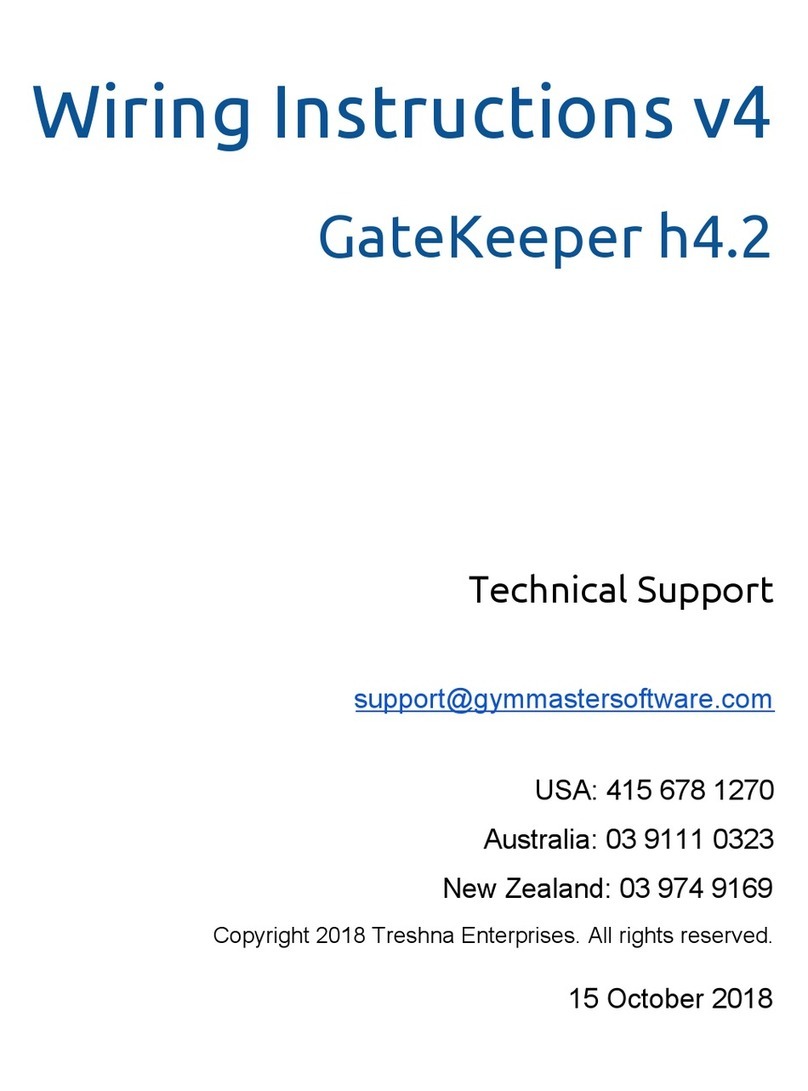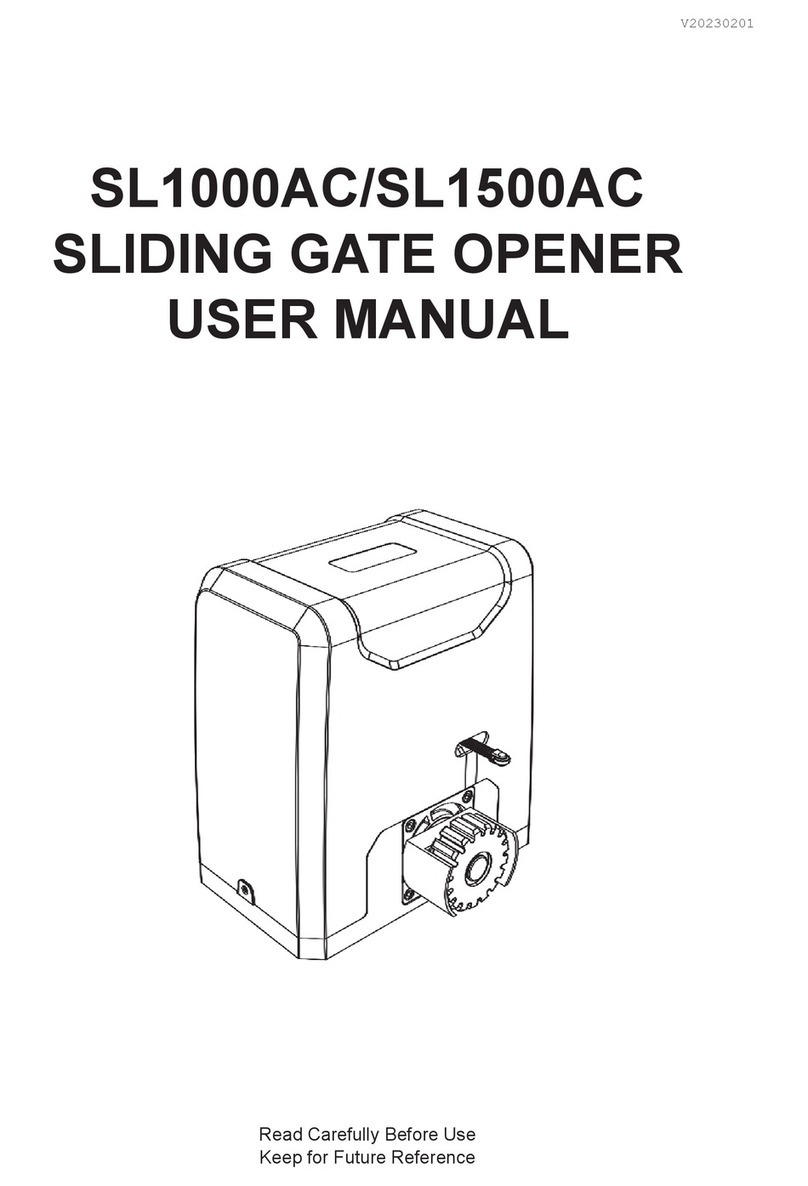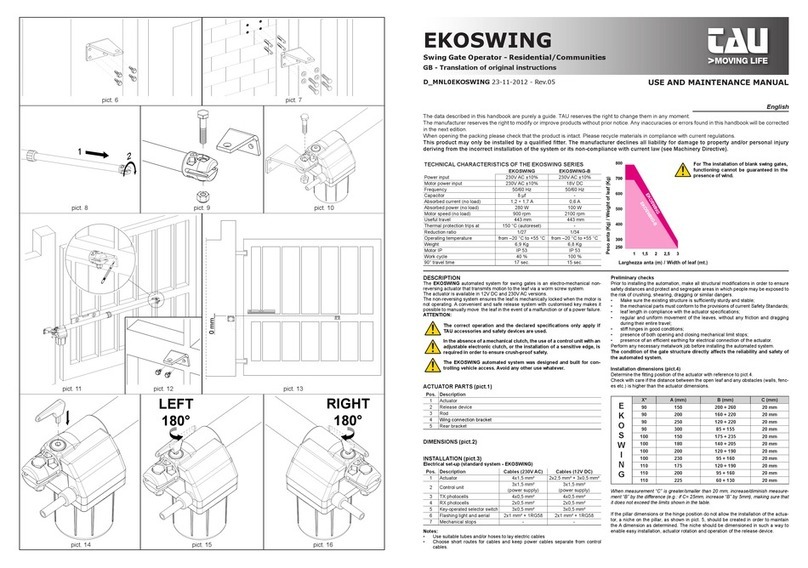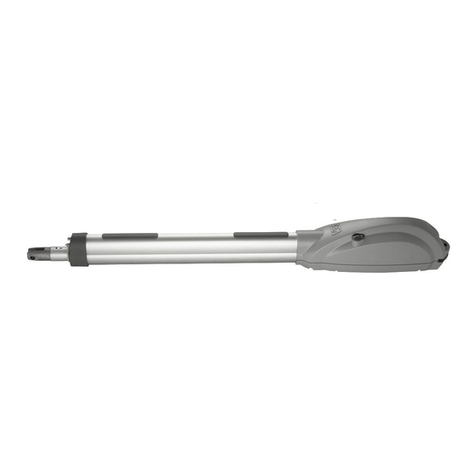Ada Ez Pro 700002 User manual

700002 Rev. F
© 2012 ADA EZ. ALL RIGHTS RESERVED. 1 of 56
Installation and
Operating Instructions
ADA EZ Pro
Installation and Operating Instructions
700002 Rev. F
EZ040
Note
Changes or modifications not expressly approved by the party responsible for compliance could void
the user’s authority to operate this device. This device complies with part 15 of the FCC Rules.
Operation is subject to the condition that this device does not cause harmful interference.
This equipment has been tested and found to comply with the limits for a Class A digital device,
pursuant to part 15 of the FCC Rules. These limits are designed to provide reasonable protection
against harmful interference when the equipment is operated in a commercial environment. This
equipment generates, uses, and can radiate radio frequency energy and, if not installed and used in
accordance with the instruction manual, may cause harmful interference to radio communications.
To obtain the latest manual and template revisions or to view installation and programming videos
go to www.ADAEZ.com.
For technical support call (877) 232-3987.

700002 Rev. F
© 2012 ADA EZ. ALL RIGHTS RESERVED. 2 of 56
Installation and Operating Instructions
TABLE OF CONTENTS
1. PURPOSE......................................................................................................................................................3
1.1 Discussion....................................................................................................................................................3
1.2 Applicability ................................................................................................................................................3
2. PREREQUISITES .........................................................................................................................................4
3. PRECAUTIONS............................................................................................................................................4
4. SYSTEM DESCRIPTION.............................................................................................................................5
4.1 General.........................................................................................................................................................5
4.2 Features and Functions.................................................................................................................................9
5. DETERMINING THE CORRECT OPERATOR APPLICATION.............................................................10
5.1 Determine the Operator and Door Arm Mounting Installation Type.........................................................10
5.2 OPERATOR AND DOOR ARM INSTALLATION INSTRUCTIONS—PUSH-SIDE APPLICATIONS
12
5.3 Mounting the Door Arm Pivot Bracket......................................................................................................15
5.1 Installing the Door Arm Pivot....................................................................................................................18
5.2 Installing the Operator Mounting Bracket .................................................................................................19
5.3 Installing the Door Operator......................................................................................................................21
5.4 Installing the Door Arm.............................................................................................................................22
6. OPERATOR AND DOOR ARM INSTALLATION INSTRUCTIONS—PULL-SIDE APPLICATIONS25
6.2 Mounting the Door Shoe............................................................................................................................28
6.3 Installing the Operator Mounting Bracket and Cover................................................................................29
6.4 Installing the Door Operator......................................................................................................................30
6.5 Installing the Door Arm.............................................................................................................................31
7. MISCELLANEOUS COMMON INSTRUCTIONS...................................................................................34
7.1 Installing the Pushbutton Switches............................................................................................................34
7.2 Connecting the Battery Pack......................................................................................................................35
7.3 Installing the Optional Plug-In Transformer..............................................................................................37
7.4 Checking Battery Voltage..........................................................................................................................39
7.5 Adjusting Door Spring Tension.................................................................................................................39
8. PROGRAMMING INSTRUCTIONS .........................................................................................................40
8.1 Programming the Operator.........................................................................................................................40
8.2 Linking the RF Pushbuttons.......................................................................................................................42
8.3 Customizing the Operator Settings (Optional)...........................................................................................42
8.4 Performing Optional Functions..................................................................................................................43
9. CLOSEOUT INSTRUCTIONS...................................................................................................................45
9.1 Closeout Procedure....................................................................................................................................45
10. TROUBLESHOOTING INSTRUCTIONS...............................................................................................46
10.1 Troubleshooting Recommendations ........................................................................................................46
Attachments
Attachment 1, Documents, Definitions, Tools, Equipment, and Consumables..................................................49
Attachment 2, Quick Programming Guide .........................................................................................................50
Attachment 3, ADA EZ Installation Schematics................................................................................................52

700002 Rev. F
© 2012 ADA EZ. ALL RIGHTS RESERVED. 3 of 56
1. PURPOSE
1.1 Discussion
This manual provides system description, installation instructions, operating instructions,
troubleshooting recommendations, and a replacement parts listing for the ADA EZ swing door
operator.
The ADA EZ is an automatic door opening and closing device that permits automatic operation
of single or double right hand or left hand doors measuring 36to 48(91 cm to 122 cm) wide
and weighing up to 250 lbs (113 kg). The door operator device mounts on a parallel-arm push-
side configuration or on a standard mount pull-side configuration.
The ADA EZ operator allows the door to open manually or by a remote transmitter device. As
the door closes the ADA EZ operator generates an electrical charge that restores power to the
operator battery. If the door is operated via remote transmitter more often than described in the
80/25 rule below, the door-closing cycle will not supply enough power to charge the battery and
permit remote operation. In this case an optional AC 110-volt transformer is available.
The ADA EZ is an extreme-duty, low-energy door opener designed for institutional, high-traffic
manual opening applications that occasionally requires powered operation. A regenerative drive
system charges an onboard battery pack, eliminating the need for electrical power. The ADA EZ
should be applied to doors using our 80/25 guideline:
Apply ADA EZ to a door that will be cycled manually a minimum of 80 times per day
and cycled automatically approximately 25% or less per day.
When applied using this 80/25 guideline the ADA EZ will self-generate all the power it needs to
keep its field-replaceable onboard battery pack charged for up to 12 years and in some cases
longer.
A fully charged battery can open a door up to 2000 times in a row with little impact on the
product’s overall usability even if there are periodic fluctuations from the 80/25 guideline. For
example 30% automatic use for one day is not a problem, so long as that level of automatic use
is not sustained.
The ADA EZ can be used in a hardwired application outside of the 80/25 parameters. Simply
plug the unit into a common 110-VAC electrical outlet using our hardwire option. The hardwire
option is a low-voltage plug-in transformer and can be added to existing installed field units.
1.2 Applicability
This manual is applicable to the ADA EZ PRO series door openers Left Hand, Right Hand, Push
Side Mounted, and Pull Side Mounted. The manual also includes instructions for installing the
hardwire option (1015P kit) and the electric lock interface (1025 kit).

700002 Rev. F
© 2012 ADA EZ. ALL RIGHTS RESERVED. 4 of 56
2. PREREQUISITES
2.1 If the door is an aluminum storefront door, make sure that you do not drill into the tie rod or the
top rail web. Also, do not drill into the junction of the style and rail.
2.2 When using the optional plug-in transformer, a 110-VAC grounded power outlet is available in
the vicinity of the door
2.3 Protective barrier (caution/warning tape) has been set up to prevent unauthorized access to work
area.
2.4 If applicable, the existing door closer has been removed.
2.5 The operator must only be installed on doors and frames in good working order, without sticking
or binding during normal operation.
2.6 The door has been secured to prevent unexpected opening or closing during installation.
2.7 Attachment 1 has been reviewed for the following:
Definitions of the terms used in this procedure
A listing of the tools, equipment, materials, and consumables used in this procedure.
3. PRECAUTIONS
3.1 Improper installation or adjustment may result in personal injury or property damage. The
operator must be completely installed and programmed or the door must be disabled prior to
leaving the site. An incomplete installation or unprogrammed operator can cause a safety hazard..
Follow all instructions carefully. For questions call ADA EZ Technical Support at the number
listed on the front of this document.
3.2 For light duty or hollow core doors with insufficient top rail blocking, the included through bolts
or sex nut and bolts must be used to securely attach the operator mounting bracket.
3.3 This product is intended for interior use only.
3.4 The operator battery should be switched “OFF” until the operator and door arm installation are
complete.
3.5 An operating door creates pinch hazards. Be careful making operating adjustments while the door
is moving.
3.6 The installation must comply with all local, state, and national electrical codes. Also,
transformer wiring must be secured to prevent it from becoming entrapped in the moving parts of
the operator or door.

700002 Rev. F
© 2012 ADA EZ. ALL RIGHTS RESERVED. 5 of 56
4. SYSTEM DESCRIPTION
4.1 General
The ADA EZ operator is shipped in the following pieces (see Figure 1):
Operator assembled with black cover installed
Optional silver and brown covers (when specified)
Door arm assembly
Operator mounting bracket
Shaft extension (pull-side applications only)
Door arm mounting shoe (pull-side applications only)
Operator mounting bracket cover
Operator mounting posts
Door arm pivot assembly (push-side applications only)
Battery assembly installed but disconnected from the operator
Two wireless pushbuttons
Operator mounting templates (right hand and left hand)
Hardware pack including fasteners for aluminum and hollow metal, wood, and all
installations
Door decals including the following:
oTwo yellow and blue “CAUTION AUTOMATIC DOOR, ACTIVATE
SWITCH TO OPERATE” decals, “PUSH TO OPERATE” and “PULL TO
OPERATE” decals for use with the optional Push and Go feature.
oOne yellow “DAILY SAFETY CHECK” decal

700002 Rev. F
© 2012 ADA EZ. ALL RIGHTS RESERVED. 6 of 56
Figure 1. ADA EZ Shipped Components

700002 Rev. F
© 2012 ADA EZ. ALL RIGHTS RESERVED. 7 of 56
Figure 2 illustrates an assembled ADA EZ operator installed on a left hand door. The paragraphs
that follow describe its components:
Figure 2. ADA EZ Assembly (Typical)

700002 Rev. F
© 2012 ADA EZ. ALL RIGHTS RESERVED. 8 of 56
4.1.1 Door Operator Assembly: Includes the following major assemblies:
Door Operator: Contains the mechanical components required to move the door.
The operator assembly mounts on the hinge or pivot edge of the door and top rail
and includes the motor/gearbox, door arm, mounting brackets, regenerative power
source, battery pack, and cover.
Door Controller: Contains the hardware and software necessary to control the
motion of the door. Figure 3 illustrates the door controller circuit board controls
and indicators.
4.1.2 Transmitter: An external device that emits an rf signal or an electrical signal to operate
the door. When pushed once, the door opens. The transmitter has a range of 85(26 m)
Figure 3. Door Controller Circuit Board Controls and Indicators

700002 Rev. F
© 2012 ADA EZ. ALL RIGHTS RESERVED. 9 of 56
from either side of the door. One 3-volt 280mAH lithium battery (Part No.CR2032)
provides transmitter power. The battery provides approximately 250,000 activations.
4.1.3 Transformer: The Optional transformer kit converts the incoming 110 VAC power to the
voltage required by the controller. Plugs into a standard 110-VAC grounded power outlet.
Transformer rating as follows: Input 120VAC 50/60Hz. Output 24 VDC 750mA.
4.2 Features and Functions
4.2.1 Opening Time: Following an activation signal, the door moves from fully closed to open
check or 80 degrees, whichever occurs first. The opening time shall be in accordance with
Table 1.
Table 1. Door Sizes and Opening/Closing Times
Door Weight (Pounds)
Door Width (Inches)
36
38
40
42
44
48
50
3.0
3.0
3.0
3.0
3.0
3.0
75
3.0
3.0
3.0
3.0
3.0
3.1
100
3.0
3.0
3.0
3.2
3.3
3.6
150
3.3
3.5
3.7
3.9
4.1
4.4
200
3.8
4.0
4.3
4.5
4.7
5.1
250
4.3
4.5
4.8
5.0
5.2
5.7
4.2.2 Hold-Open Time: Hold open time shall be adjusted to no less than 5 seconds
4.2.3 Closing Time: Following hold-open time, the door moves from fully open to close check
or 10, whichever occurs first, according to Table 1.
4.2.4 Close Check: Close check shall occur in the last 10 degrees of closing and shall not be
less than 1.5 seconds
4.2.5 Closing Force: The door shall not close with a force greater than 15 lbs (6.8 kg) when
measured at the latch side of the closing stile. For ADA EZ series, the closing force is
adjustable to 8 lbs (3.6 kg).
4.2.6 Opening Force: The door shall not open with a force greater than 15 lbs (6.8 kg) when
measured at the latch side of the opening stile.
4.2.7 Transmitter Range: The transmitter has a range of 85(26 m) from either side of the door.
4.2.8 Operation Upon Loss of Power: Standard installations require no external power and
operation will not be affected during a power loss. Typically a maximum of 2,500 cycles
can be obtained from a fully charged battery pack. Installations with the optional power
transformer will continue to function normally.
4.2.9 Operation Upon Obstruction: If the door meets an obstruction while opening, the door
will remain under power for one second and then close under spring force. If the door
meets an obstruction while closing, the door will maintain a closing force of 8 lbs (3.6 kg)
or less.
4.2.10 Transmitter Learn Mode: The transmitter learn mode programs the transmitter to the
operator. The system can learn up to eight separate transmitters. The system also has the
ability to remove all transmitters programmed into memory.
4.2.11 Auto-Tune Mode: The auto-tune mode allows the door to “learn” its fully open and fully
closed positions and adjusts the open time, close time, open force, and hold open times to
ensure the settings meet the ANSI 156.19 Low Energy Door Operator Code.

700002 Rev. F
© 2012 ADA EZ. ALL RIGHTS RESERVED. 10 of 56
4.2.12 Option Features: Power Close, Push and Go, Dynamic Breaking.
Power Close: The door operator will apply a small amount of power if the door did not
close in the expected close time to assist in closing the door. Once the door is fully
closed power close will turn off.
Push and Go: The operator will power open the door when a manual open cycle is
initiated.
Dynamic Braking: The operator will brake the door if excessive door speed occurs
resulting, for example, from a wind load or an abusive open condition.
4.2.13 Hold Open: The operator provides an adjustable hold open time. Controls on the circuit
board allow adjustment of the door-closing time delay from 1 second to 30 seconds.
5. DETERMINING THE CORRECT OPERATOR APPLICATION
5.1 Determine the Operator and Door Arm Mounting Installation Type
CAUTION
The operator must only be installed on doors and frames that are in good working order. The door must
not stick or bind during normal operation.
If applicable, the existing door closer must be removed before installing the ADA EZ operator.
The operator must be completely installed and programmed or the door must be disabled prior to leaving
the site. An incomplete installation or unprogrammed operator can cause a safety hazard.
NOTE
A push-mount operator always mounts on the inside (push side) of the door at the hinge or pivot
edge of the top rail. A pull-mount operator always mounts on the outside (pull-to-open) of the
door.
The ADA EZ will not work on balanced doors or doors with swing clear hinges.
.
5.1.1 Refer to Figure 4, and DETERMINE desired door handing.
5.1.2 Refer to Figure 5, and DETERMINE if the door is a push-side application or a pull-
side application.
If the door is a push-side application, GO TO Section 5.2.
If the door is a pull-side application, GO TO Section 6.
NOTE
Power Close and Push and Go must only be enabled when the unit is powered using the optional plug in
transformer.

700002 Rev. F
© 2012 ADA EZ. ALL RIGHTS RESERVED. 11 of 56
Figure 4. Door Handing
LEFT HAND INSWING
NOTES
1. When the door opens toward you and the knob is on the left hand side, it is a LEFT HAND DOOR. When the door
opens toward you and the knob is on the right hand side, it is a RIGHT HAND DOOR.
2. For the ADA EZ operator, a LH door uses a left hand operator and a RH door uses a right hand operator.
RIGHT HAND INSWING LEFT HAND OUTSWING RIGHT HAND OUTSWING
EZ041A
Figure 5. Determining if the Door is a Push-Side or Pull-Side Application

700002 Rev. F
© 2012 ADA EZ. ALL RIGHTS RESERVED. 12 of 56
5.2 OPERATOR AND DOOR ARM INSTALLATION INSTRUCTIONS—PUSH-SIDE
APPLICATIONS
NOTE
The operator always mounts on the inside of the door at the hinge or pivot edge of the top rail.
The template provides for Right Hand door mounting on one side and Left Hand door mounting on the
opposite side..
The template has a solid-line outline and a dotted-line outline. The solid-line outline is for the narrow rail
door. The dotted line outline is for the medium or wide rail doors.
Each template provides two additional hole slots. These can be used when the solid-line outline or dotted-
line outline mounting holes will interfere with a top rail web, rail-to-stile tie rod(s), or the rail-to-stile
junction.
5.2.1 SELECT the right hand or left hand operator mounting template as applicable.
5.2.2 EXAMINE the inside door top rail and DETERMINE the top rail width (narrow,
medium, or wide).
5.2.3 DETERMINE the type of mounting hinge (butt or continuous, center pivot, or offset.
CAUTION
On an aluminum storefront door, the operator mounting holes must not be drilled into the top rail web, rail-
to-stile tie rod(s), or the rail-to-stile junction.
5.2.4 If the door is an aluminum storefront door, EXAMINE the top rail, and, when drilling the
mounting holes, ENSURE the following:
Do not drill into the top rail web
Do not drill into the rail-to-stile tie rod(s)
Do not drill into the rail-to-stile junction
5.2.5 Refer to Figures 6 and 9, and DETERMINE which operator mounting template fold line
to use as follows:
a. MEASURE the stop thickness.
If the stop is greater than 11/2″(38.1 mm), USE the upper template fold line.
If the stop is 11/2″ (38.1 mm), or less, USE the lower template fold line.
b. If the door is a narrow-stile door, USE the solid line mounting location.
c. If the door is an application other than a narrow-stile door, USE the dotted line
mounting location.

700002 Rev. F
© 2012 ADA EZ. ALL RIGHTS RESERVED. 13 of 56
Figure 6. Determining Which Mounting Template Fold Line to Use

700002 Rev. F
© 2012 ADA EZ. ALL RIGHTS RESERVED. 14 of 56
5.2.6 Refer to Figure 7, and ALIGN the operator mounting template to the centerline of the
butt hinge, center pivot, or offset pivot as applicable.
Figure 7. Installing the Operator Mounting Template

700002 Rev. F
© 2012 ADA EZ. ALL RIGHTS RESERVED. 15 of 56
CAUTION
To ensure proper installation, the operator must be fastened with at least four fasteners. For heavier doors
more fasteners are recommended.
For light duty or hollow-core doors with insufficient top rail blocking, the included through bolts or sex
nut and bolts must be used to securely attached the operator mounting bracket.
5.2.7 Using a center punch, MARK the mounting hole locations.
5.2.8 Refer to Figure 8, and, using a square, MARK the centerline of the arm pivot onto the
underside and face of the frame header and door stop. (This line is shown on the
template.)
5.3 Mounting the Door Arm Pivot Bracket
NOTE
The face of the vertical support must be flush against the face of the frame header. On some door
installations, the door stop prevents the bracket from setting flush. If this is the case, the arm pivot bracket
can be adjusted by removing the bracket vertical support and reversing it.
In a flush mount installation, the ceiling covers the frame face. In this case, the vertical support of the
bracket must be removed. The bracket should then be mounted to the underside of the frame header.
5.3.1 Refer to Figure 9, and DETERMINE the orientation of the door arm pivot bracket as
necessary to ensure the following (as applicable):
If the door is a typical installation, the vertical support will set flush against the face of
the frame header.
If the door is a large reveal installation, the bracket will mount to the underside of the
frame header.
Figure 8. Marking the Centerline of the Arm Pivot
EZ043

700002 Rev. F
© 2012 ADA EZ. ALL RIGHTS RESERVED. 16 of 56
The edge of the bracket will be between 5/8″(15.87 mm) and 1 1/2″(38.1 mm) from the
face of door.
Figure 9. Determining the Door Arm Pivot Bracket Orientation

700002 Rev. F
© 2012 ADA EZ. ALL RIGHTS RESERVED. 17 of 56
CAUTION
To ensure proper installation, the door arm pivot bracket must be fastened to the underside of the header
frame and to the face of the header frame with at least three fasteners.
NOTE
When attempting to install the rivnuts to the underside of the door frame it may be necessary to remove the
door stop.
5.3.2 Refer to Figure 10 and, using a center punch, MARK the door arm pivot bracket hole
locations.
5.3.3 If the door frame is aluminum and rivnuts must be installed, PERFORM the following:
a. Using a 25/64″drill, DRILL the door arm pivot bracket holes.
b. Using a rivnut tool, INSTALL the ¼-20 steel rivnuts.
c. INSTALL and TIGHTEN the three (minimum) ¾″ (19.05 mm) socket head
capscrews securing the door arm pivot bracket to the underside and face of the frame
header.
5.3.4 If the door frame is wood, PERFORM the following:
a. Using a 5/32″ (3.97 mm) drill, DRILL the door arm pivot bracket pilot holes.
b. INSTALL and TIGHTEN the three #14 x 1 ¼″ wood screws (minimum) securing
the door arm pivot bracket to the underside and face of the frame header.
Figure 10. Mounting the Door Arm Pivot Bracket

700002 Rev. F
© 2012 ADA EZ. ALL RIGHTS RESERVED. 18 of 56
5.1 Installing the Door Arm Pivot
5.1.1 Refer to Figure 11, and SLIDE the door arm pivot over the door arm pivot bracket.
5.1.2 ENSURE that the dimension from the face of the door to the centerline of the door arm
mounting hole is 6 3/8″(161.92 mm).
5.1.3 TIGHTEN the four set screws securing the door arm pivot to the door arm pivot bracket.
Figure 11. Installing the Door Arm Pivot

700002 Rev. F
© 2012 ADA EZ. ALL RIGHTS RESERVED. 19 of 56
5.2 Installing the Operator Mounting Bracket
5.2.1 Refer to Figure 12, and DETERMINE the proper operator mounting bracket location.
Figure 12. Determining the Operator Mounting Bracket Location

700002 Rev. F
© 2012 ADA EZ. ALL RIGHTS RESERVED. 20 of 56
5.2.2 If the door is aluminum rivnuts must be installed, PERFORM the following:
Using a 25/64″ (9.92 mm) drill, DRILL the operator mounting bracket holes.
5.2.3 Using a rivnut tool, INSTALL the ¼-20 steel rivnuts.
NOTE
For light duty or hollow-core doors with insufficient top rail blocking, through bolts or sex nut and bolts
are required to securely attached the operator mounting bracket.
5.2.4 If the door is wood or hollow metal, PERFORM the following:
Using a 3/8″ (9.52 mm) drill, DRILL the operator mounting bracket holes.
5.2.5 INSTALL and TIGHTEN the supplied through-bolts, the four ¼-20 (6.35 mm) socket
head capscews (with supplied washers) securing the operator mounting bracketINSTALL
a washer onto each of the four (minimum) ¾″(19.05 mm) socket head operator mounting
bracket capscrews.
5.2.6 INSTALL, but do not TIGHTEN the socket head capscrews securing the operator
mounting bracket to the door.
5.2.7 ADJUST the operator mounting bracket as follows:
If the upper fold on the operator mounting template was used (large stop mounting),
ADJUST the bracket so that there is 2 3/8″ (60.32 mm) space between the top of the
bracket and the top of the door.
If the lower fold on the operator mounting template was used (standard mounting),
ADJUST the bracket so that there is 1¾″ (44.45mm) space between the top of the
bracket and the top of the door.
If the narrow stile door mounting location was used (solid line on operator mounting
template), ADJUST the bracket so that there is 1/2″ (12.7 mm) space between the top
of the bracket and the top of the door.
5.2.8 TIGHTEN the socket head capscrews securing the operator mounting bracket to the door.
NOTE
The operator mounting bracket includes four threaded holes that accept the operator mounting pins. The
lower set of two threaded holes is used when the operator is installed on a narrow-rail door. The upper set
of two threaded holes is used when the operator is installed on a medium- or wide-rail door.
5.2.9 Refer to Figure 12 and PERFORM one of the following as applicable:
If the operator is being mounted to a narrow rail door, TIGHTEN the operator
mounting pins into the lower threaded holes in the mounting bracket using a 7/16″
(11.112 mm) box wrench or large adjustable wrench.
If the operator is being mounted to a wide or medium rail door, TIGHTEN the
operator mounting pins into the upper threaded holes in the mounting bracket using a
7/16″ (11.112 mm) box wrench or large adjustable wrench.
Table of contents
Popular Gate Opener manuals by other brands

HySecurity
HySecurity Nice 3501 installation manual

Elite
Elite CSW200UL instruction manual

GiBiDi
GiBiDi PASS 600 Instructions for installations

US Automatic
US Automatic Ranger 500 S Installation & owner's manual

Elite
Elite CSW200UL instruction manual
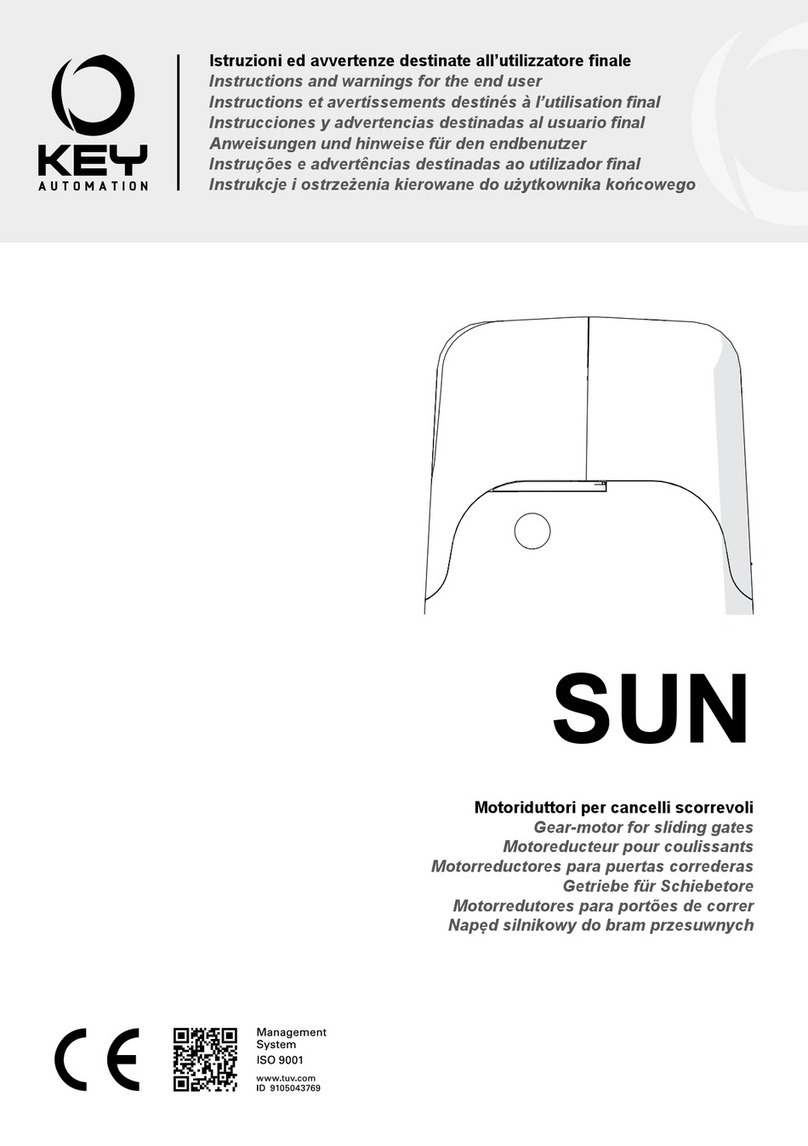
Keyautomation
Keyautomation KSUN4024TW Instructions and warnings

Roger Technology
Roger Technology SMARTY Series INSTRUCTIONS AND RECOMMENDATIONS FOR THE INSTALLER

DITEC
DITEC GLOBE IP1839 Installation and maintenance manual

Locinox
Locinox Samson-2 Installation instruction

Ribind
Ribind BOSS 230V MASTER IP44 manual

Genius
Genius MISTRAL Series GUIDE FOR THE INSTALLER
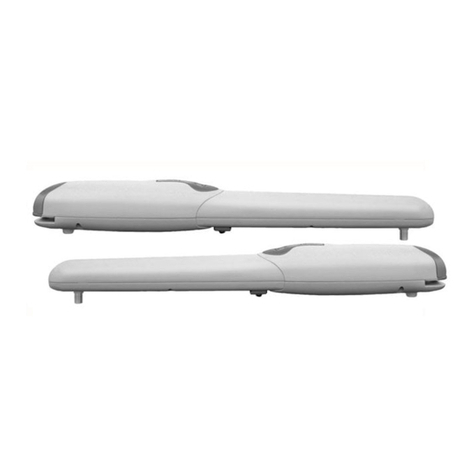
Nice
Nice 5024 Kit Instructions and warnings for installation and use
